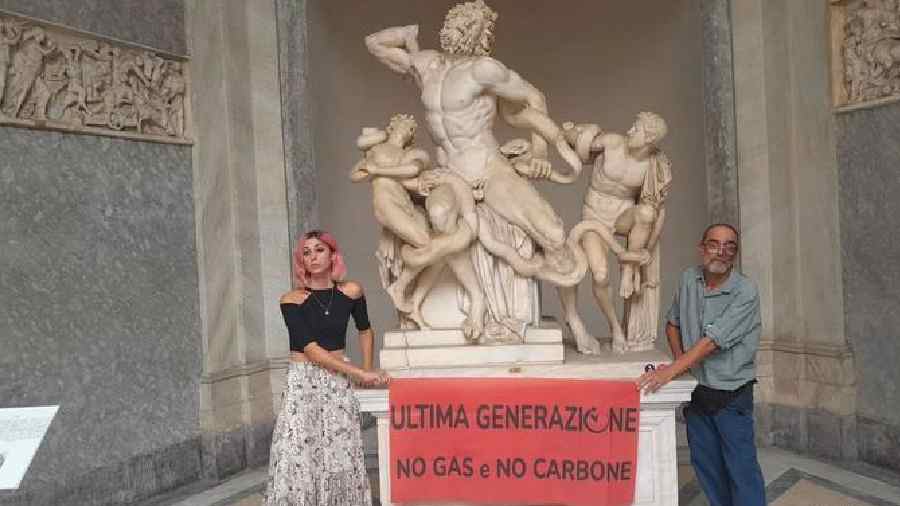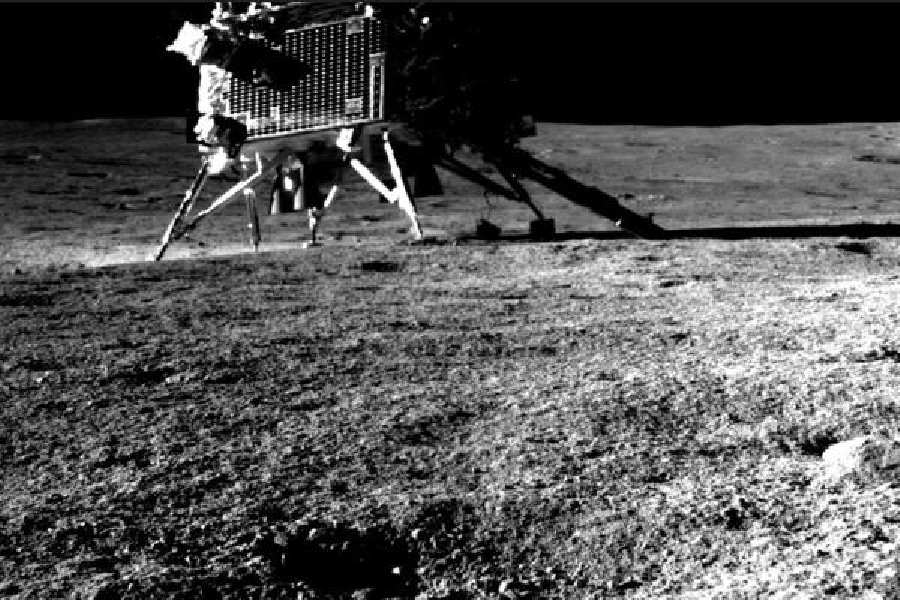From the United Kingdom to Italy and Germany, climate activists have been attaching themselves to celebrated artworks to bring attention to their key demand: ending new gas and oil extraction projects.
As Europe suffers unprecedented wildfires and its worst drought in centuries, activists say they want to better communicate the severity of the climate crisis and the need to end burning the fossil gas and oil that fuel it.
In addition to street protests, or coal power plant blockades, campaigners are now targeting iconic artworks to symbolically highlight environmental breakdown.
The art of climate protest
"Nature is art's greatest muse," Simon Bramwell, an activist who has helped organize art actions with the United Kingdom's Just Stop Oil coalition, told DW.
He refers to particular paintings and sculptures that "make narrative sense and resonate with the climate crisis itself."
On July 1, the UK activists glued themselves to the frame of J.M.W. Turner's 1809 romantic painting, "Tomson's Aeolian Harp," which portrays a bucolic outer London landscape around the Thames River that could be regularly flooded by 2030, according to climate experts.
The action at the Manchester Art Gallery included spay-painting the words "no new oil" on the floor.
"Symbolism is one of the ways humans have understood our world for tens of thousands of years," Bramwell said, referring to another July action where he and others affixed to a copy of Leonardo da Vinci's "The Last Supper" at The Royal Academy in London.
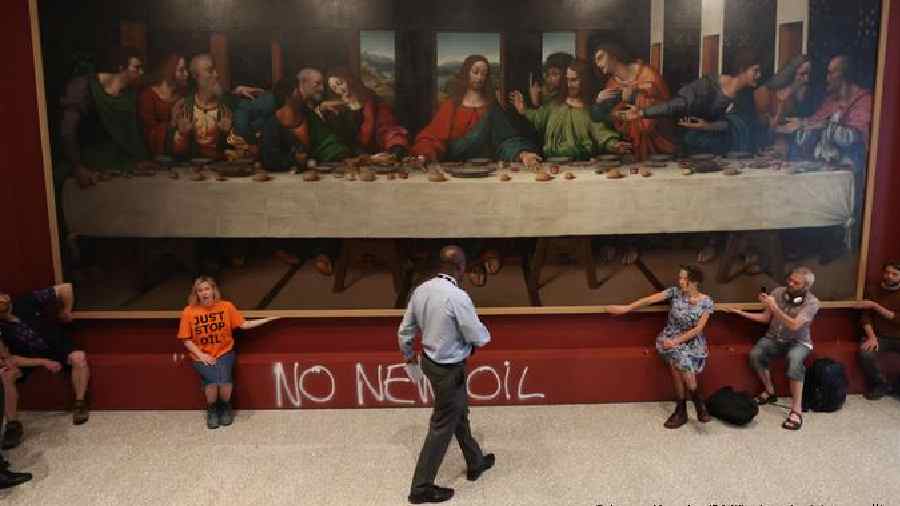
Activists glue their hands to the frame of a copy of Leonardo da Vinci's Deutsche Welle
"It is possibly one of the most iconic representations of Western values and spirituality," he said of the work. The painting also resonates with "crop failure" and the increasing malnutrition linked to climate change. "We have a whole generation for whom it may be the last supper," he said
This symbolism was highlighted when two members of Italian climate activist group Ultima Generazione (Last Generation) glued themselves to the ancient statue of the priest "Laocoon" at the Vatican Museums. The priest of Apollo in the city of Troy warned his fellow Trojans against taking in the wooden horse left by the Greeks outside the city gates.
But, as with the appeals of today's climate scientists, very few listened — and the city was destroyed.
"This statue reminds us the sad story of the Greek priest that tried to save himself, his children and all citizens of Troy," said Laura, an Ultima Generazione activist. She added that their action was symbolic of a movement "united by the will of influencing our government to make the right choices in order to mitigate climate change."
Art actions have a long tradition
The exploitation of art to make a political statement has a long and often extreme tradition.
Bramwell refers to the art vandalism of a British suffragette who used a meat cleaver to slash a portrait of philosopher Thomas Carlyle in London in 1914 — and subsequently went to jail for her feminist culture action.
Chinese artist Ai Weiwei's provocative 1995 work, "Dropping a Han Dynasty Urn," saw him smash a 2,000-year-old prized cultural symbol. Ai not only criticized modern China but created what remains his most famous work.
Just Stop Oil say they have a lot of "respect and love for art itself as an institution."
"We're not slashing paintings as the suffragettes have done," Bramwell said. What he calls "dissident and iconoclastic" actions are carefully planned to cause as little damage as possible to the targeted works.
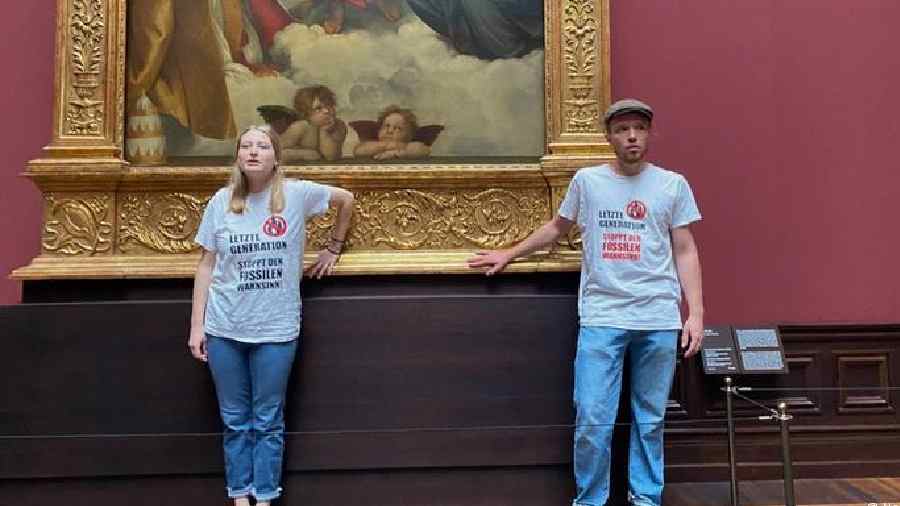
German activists from climate group Letzte Generation are also embracing art action, having affixed themselves to Raphael's iconic Deutsche Welle
For example, Just Stop Oil carefully prepared the action in July whereby they covered John Constable's "The Hay Wain" (1821) with a color printout showing the idyllic river landscape replaced by a paved road, dead trees, factory smokestacks and airplanes.
The work was partly chosen because an art restorer advised Bramwell and his team that it had the requisite layers of paint and lacquer to withstand a light adhesive.
The painting was examined by the gallery's conservation team following the action. "'The Hay Wain' suffered minor damage to its frame and there was also some disruption to the surface of the varnish on the painting — both of which have now been successfully dealt with," a spokeswoman from the gallery told the Museums Association in the UK.
After Ultima Generazione activists glued their hands to the glass panel protecting Sandro Botticelli’s "Primavera" at the Uffizi Gallery in Florence on July 22, they said they had consulted with experts about a suitable glue. "It’s important for us to value art, instead of damaging it, like our governments do with the only planet," the group said in a statement.
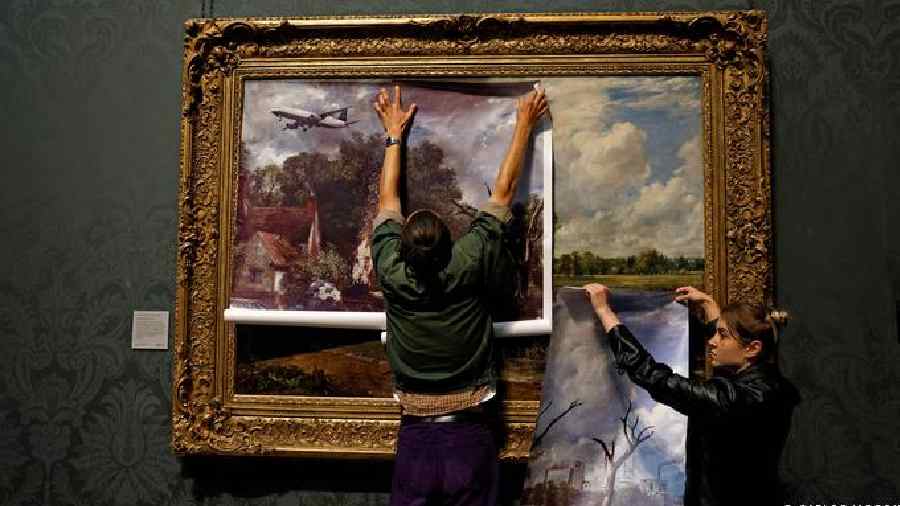
Activists overlay the idyll in Deutsche Welle
Museums critical but also offer tepid support
German climate activists Letzte Generation (Last Generation) have also targeted artworks in recent weeks, including on Wednesday, when two members glued their hands to the painting "Thunderscape With Pyramus and Thisbe" by Nicolas Poussin at the Städel Museum in Frankfurt.
"The painting today is symbolic of the destructive course of current politics," the group said in a statement. It depicts Pyramus lying on the ground with the sword next to him he used to tragically kill himself after making a wrong assumption about his lover.
"Just as Pyramus started from false assumptions, our government is starting from false assumptions that will lead our societies to collapse," the group said, referring to to continuing development of coal and gas power projects.
This came a day after two Letzte Generation members affixed themselves to the frame of Raphael's "Sistine Madonna" in the Old Masters Picture Gallery in Dresden.
But Olaf Zimmermann, the executive director of the German Cultural Council, does not agree with the strategy.
"As much as I can understand the despair of the climate activists, I say clearly that the actions of sticking oneself to frames of famous works of art are clearly the wrong way to go," he said.
Speaking after the action by Letzte Generation, he said "the risk of damaging the artworks is very high."
"The works put in danger belong to the world cultural heritage and need to be protected as well as our climate," he added.
But Just Stop Oil's Simon Bramwell, who was a co-founder of the Extinction Rebellion climate activist movement, said it was time that the art world stand with the climate cause.
While major art institutions like the London's Tate gallery and the Van Gogh Museum in Amsterdam have refused sponsorships from fossil fuel companies suich as BP and Shell in recent years, Just Stop Oil want deeper commitments — including a complete shutdown until governments promise to end new fossil fuel projects.
"Art institutions need to become the adults in the room," he said, referring to a lack of government action on the climate crisis.

